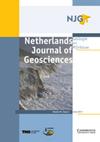荷兰heet Gooi边界地带全新世最大地下水位和相关泥炭扩展:基于土壤样带研究的重建
IF 2.3
2区 地球科学
Q3 GEOSCIENCES, MULTIDISCIPLINARY
Netherlands Journal of Geosciences-Geologie En Mijnbouw
Pub Date : 2020-06-09
DOI:10.1017/njg.2020.7
引用次数: 1
摘要
荷兰的“Het Gooi”地区是更新世冰推脊系统的一部分,该系统在全新世期间因海平面和相关地下水上升而部分淹没。结果,山脊系统逐渐被泥炭侵蚀。从中世纪晚期开始,人类开垦了heet Gooi周围的泥炭地,大大减少了泥炭地的延伸,并通过日益密集的排水降低了该地区的地下水位。根据历史和考古学的观点,一些作者认为,全新世泥炭覆盖在“Het Gooi”边界地带形成了大型凸起泥炭沼泽的延伸,这些泥炭沼泽分别向西和向东进一步形成。他们推测,在中世纪晚期,这些延伸达到了“上坡”的最高高度3米+ NAP(荷兰军械基准面-近似平均海平面)。然而,原来的延伸部分很难重建,因为这些泥炭即使曾经存在,也已经因为开采和氧化而消失了。基于土壤特征,重建了全新世泥炭覆盖在冰推脊系统上的最大扩展。所使用的土壤特征涉及沙粒周围铁涂层的存在和地表特征的上边界,因为这些是平均最高地下水位(MHG)的指标。为了形成泥炭,这个MHG需要在一年的大部分时间里处于或刚刚高于地面。通过对大量土壤样带的研究,我们重建了泥炭侵蚀可能发生的最大高度。这种“最大延伸”也可以被描述为覆盖山脊系统的泥炭底部的最大高度。在西部边境地区,泥炭覆盖层被发现达到了c. NAP或稍高,在希尔弗瑟姆附近。没有发现饲养沼泽发生的迹象。我们认为,该地区的潜水地下水位受海平面和相关湖泊(Naardermeer和Horstermeer)水位的控制,其中浅层的更新世地层具有较高的水力传导性,起着主导作用。东部边境地区海拔变化较大,部分地区可达2 m + NAP。这一较高海拔的泥炭可能是在邻近的冰川盆地(Eem山谷)中存在的具有低水力导电性的黏性Eem填充物引起的较高的潜水地下水位的影响下形成的。该研究证明了详细的土壤样带研究对欧洲西北部更新世前全新世泥炭覆盖古地理重建的价值。它还为此类景观的地质水文模型的验证提供了独立的数据。本文章由计算机程序翻译,如有差异,请以英文原文为准。
Maximum Holocene groundwater levels and associated extension of peat in the border zone of ‘Het Gooi’ (the Netherlands): a reconstruction based on the study of soil transects
Abstract The area ‘Het Gooi’ in the Netherlands is part of a Pleistocene ice-pushed ridge system that partially drowned during the Holocene upon sea level and associated groundwater rise. As a result, the ridge system was gradually encroached by peat. From the late Middle Ages onward, man reclaimed the peatlands surrounding Het Gooi, heavily reducing their extension and lowering the regional groundwater level by increasingly intensive drainage. Based on historical and archaeological arguments, several authors assume that the Holocene peat cover in the border zones of ‘Het Gooi’ formed the extension of large raised peat bogs that formed further to the west and east, respectively. They presume that in the late Middle Ages these extensions reached ‘upslope’ to a maximum altitude of 3 m + NAP (Dutch Ordnance Datum – approximating mean sea level). However, the original extension is difficult to reconstruct, as this peat has disappeared as a result of its exploitation and oxidation, if having been present at all. In this study, the maximum extension of the Holocene peat cover on the ice-pushed ridge system was reconstructed based on soil characteristics. Used soil characteristics concerned the presence of iron coatings around sand grains and the upper boundary of gleyic features, because these are indicators for the mean highest groundwater level (MHG). For peat to form, this MHG needs to be at or just above the ground surface for most of the year. Based on study of a number of soil transects, we reconstructed to what maximum altitude peat encroachment may have occurred. This ‘maximum extension’ can alternatively be described as the maximum altitude of the bottom of the peat onlapping the ridge system. In the western border zone, this peat cover was found to have reached to c. NAP or just above, near Hilversum. No indications were found for the occurrence of raised bogs. We conclude that the phreatic groundwater level in this zone was controlled by the sea level and associated lake levels (Naardermeer and Horstermeer), a dominant role being played by the shallow presence of Pleistocene formations with a high hydraulic conductivity. In the eastern border zone, altitudes were more variable and in places reached 2 m + NAP. Peat at this higher elevation probably formed under the influence of a higher phreatic groundwater level, induced by the presence of a clayey Eemian fill with low hydraulic conductivity in the adjacent glacial basin (the Eem valley). This study demonstrates the value of detailed soil transect studies for palaeogeographical reconstructions of the former Holocene peat cover in Pleistocene landscapes of NW Europe. It also provides independent data for validation of geohydrological models for such landscapes.
求助全文
通过发布文献求助,成功后即可免费获取论文全文。
去求助
来源期刊
CiteScore
4.00
自引率
25.90%
发文量
14
审稿时长
>12 weeks
期刊介绍:
Netherlands Journal of Geosciences - Geologie en Mijnbouw is a fully open access journal which publishes papers on all aspects of geoscience, providing they are of international interest and quality. As the official publication of the ''Netherlands Journal of Geosciences'' Foundation the journal publishes new and significant research in geosciences with a regional focus on the Netherlands, the North Sea region and relevant adjacent areas. A wide range of topics within the geosciences are covered in the journal, including "geology, physical geography, geophyics, (geo-)archeology, paleontology, hydro(geo)logy, hydrocarbon exploration, modelling and visualisation."
The journal is a continuation of Geologie and Mijnbouw (published by the Royal Geological and Mining Society of the Netherlands, KNGMG) and Mededelingen Nederlands Instituut voor Toegepaste Geowetenschappen (published by TNO Geological Survey of the Netherlands). The journal is published in full colour.

 求助内容:
求助内容: 应助结果提醒方式:
应助结果提醒方式:


